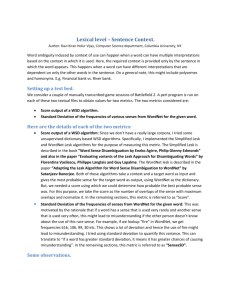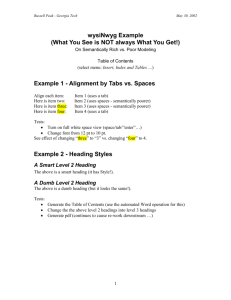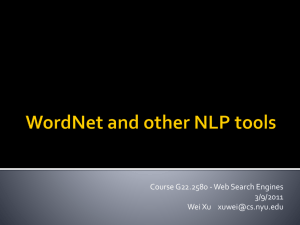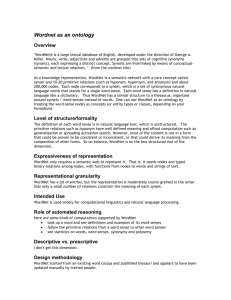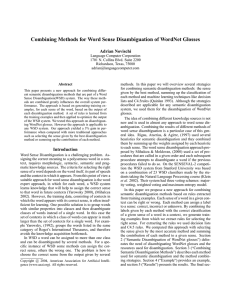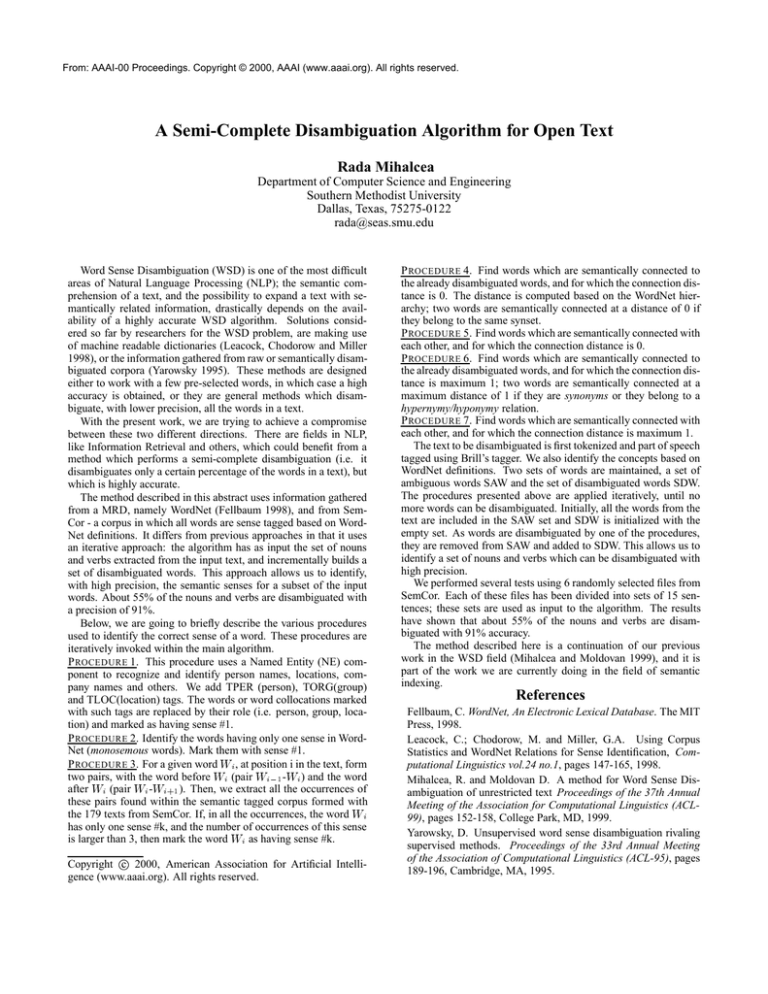
From: AAAI-00 Proceedings. Copyright © 2000, AAAI (www.aaai.org). All rights reserved.
A Semi-Complete Disambiguation Algorithm for Open Text
Rada Mihalcea
Department of Computer Science and Engineering
Southern Methodist University
Dallas, Texas, 75275-0122
rada@seas.smu.edu
Word Sense Disambiguation (WSD) is one of the most difficult
areas of Natural Language Processing (NLP); the semantic comprehension of a text, and the possibility to expand a text with semantically related information, drastically depends on the availability of a highly accurate WSD algorithm. Solutions considered so far by researchers for the WSD problem, are making use
of machine readable dictionaries (Leacock, Chodorow and Miller
1998), or the information gathered from raw or semantically disambiguated corpora (Yarowsky 1995). These methods are designed
either to work with a few pre-selected words, in which case a high
accuracy is obtained, or they are general methods which disambiguate, with lower precision, all the words in a text.
With the present work, we are trying to achieve a compromise
between these two different directions. There are fields in NLP,
like Information Retrieval and others, which could benefit from a
method which performs a semi-complete disambiguation (i.e. it
disambiguates only a certain percentage of the words in a text), but
which is highly accurate.
The method described in this abstract uses information gathered
from a MRD, namely WordNet (Fellbaum 1998), and from SemCor - a corpus in which all words are sense tagged based on WordNet definitions. It differs from previous approaches in that it uses
an iterative approach: the algorithm has as input the set of nouns
and verbs extracted from the input text, and incrementally builds a
set of disambiguated words. This approach allows us to identify,
with high precision, the semantic senses for a subset of the input
words. About 55% of the nouns and verbs are disambiguated with
a precision of 91%.
Below, we are going to briefly describe the various procedures
used to identify the correct sense of a word. These procedures are
iteratively invoked within the main algorithm.
P ROCEDURE 1. This procedure uses a Named Entity (NE) component to recognize and identify person names, locations, company names and others. We add TPER (person), TORG(group)
and TLOC(location) tags. The words or word collocations marked
with such tags are replaced by their role (i.e. person, group, location) and marked as having sense #1.
P ROCEDURE 2. Identify the words having only one sense in WordNet (monosemous words). Mark them with sense #1.
P ROCEDURE 3. For a given word i , at position i in the text, form
two pairs, with the word before i (pair i 1 - i ) and the word
after i (pair i - i+1 ). Then, we extract all the occurrences of
these pairs found within the semantic tagged corpus formed with
the 179 texts from SemCor. If, in all the occurrences, the word i
has only one sense #k, and the number of occurrences of this sense
is larger than 3, then mark the word i as having sense #k.
W
WW
W
W
W
W W
W
Copyright c 2000, American Association for Artificial Intelligence (www.aaai.org). All rights reserved.
P ROCEDURE 4. Find words which are semantically connected to
the already disambiguated words, and for which the connection distance is 0. The distance is computed based on the WordNet hierarchy; two words are semantically connected at a distance of 0 if
they belong to the same synset.
P ROCEDURE 5. Find words which are semantically connected with
each other, and for which the connection distance is 0.
P ROCEDURE 6. Find words which are semantically connected to
the already disambiguated words, and for which the connection distance is maximum 1; two words are semantically connected at a
maximum distance of 1 if they are synonyms or they belong to a
hypernymy/hyponymy relation.
P ROCEDURE 7. Find words which are semantically connected with
each other, and for which the connection distance is maximum 1.
The text to be disambiguated is first tokenized and part of speech
tagged using Brill’s tagger. We also identify the concepts based on
WordNet definitions. Two sets of words are maintained, a set of
ambiguous words SAW and the set of disambiguated words SDW.
The procedures presented above are applied iteratively, until no
more words can be disambiguated. Initially, all the words from the
text are included in the SAW set and SDW is initialized with the
empty set. As words are disambiguated by one of the procedures,
they are removed from SAW and added to SDW. This allows us to
identify a set of nouns and verbs which can be disambiguated with
high precision.
We performed several tests using 6 randomly selected files from
SemCor. Each of these files has been divided into sets of 15 sentences; these sets are used as input to the algorithm. The results
have shown that about 55% of the nouns and verbs are disambiguated with 91% accuracy.
The method described here is a continuation of our previous
work in the WSD field (Mihalcea and Moldovan 1999), and it is
part of the work we are currently doing in the field of semantic
indexing.
References
Fellbaum, C. WordNet, An Electronic Lexical Database. The MIT
Press, 1998.
Leacock, C.; Chodorow, M. and Miller, G.A. Using Corpus
Statistics and WordNet Relations for Sense Identification, Computational Linguistics vol.24 no.1, pages 147-165, 1998.
Mihalcea, R. and Moldovan D. A method for Word Sense Disambiguation of unrestricted text Proceedings of the 37th Annual
Meeting of the Association for Computational Linguistics (ACL99), pages 152-158, College Park, MD, 1999.
Yarowsky, D. Unsupervised word sense disambiguation rivaling
supervised methods. Proceedings of the 33rd Annual Meeting
of the Association of Computational Linguistics (ACL-95), pages
189-196, Cambridge, MA, 1995.





